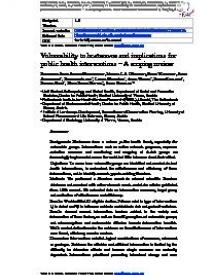Vulnerability to heatwaves and implications for public health interventions : A scoping review
Abstract
Background
Heatwaves form a serious public health threat, especially for vulnerable groups. Interventions such as active outreach programs, exposure reduction measures and monitoring and mapping of at-risk groups are increasingly implemented across the world but little is known about their effect.
Objectives
To assess how vulnerable groups are identified and reached in heat health interventions, to understand the effectiveness and efficiency of those interventions, and to identify research gaps in existing literature.
Methods
We performed a literature search in relevant scientific literature databases and searched with a four element search model for articles published from 1995 onward. We extracted data on intervention measures, target group and evaluation of effectiveness and efficiency.
Results
We identified 23 eligible studies. Patterns exist in type of interventions 1) to detect and 2) to influence extrinsic and intrinsic risk and protective factors. Results showed several intervention barriers related to the variety and intersection of these factors, as well as the self-perception of vulnerable groups, and misconceptions and unfavorable attitudes towards intervention benefits. While modest indications for the evidence on the effectiveness of interventions were found, efficiency remains unclear.
Discussion
Interventions entailed logical combinations of measures, subsumed as packages. Evidence for effective and efficient intervention is limited by the difficulty to determine effects and because single measures are mutually dependent. Interventions prioritized promoting behavioral change and were based on behavioral assumptions that remain untested and mechanisms not worked out explicitly.
Conclusions
Multifaceted efforts are needed to tailor interventions, compiled in heat health warning systems and action plans for exposure reduction and protection of vulnerable populations, to fit the social, economic and geographical context. Besides adequately addressing relevant risk and protective factors, the challenge is to integrate perspectives of vulnerable groups. Future research should focus on intervention barriers and improving the methods of effectiveness and efficiency evaluation.
Geachte bezoeker,
De informatie die u nu opvraagt, kan door psychotraumanet niet aan u worden getoond. Dit kan verschillende redenen hebben,
waarvan (bescherming van het) auteursrecht de meeste voorkomende is. Wanneer het mogelijk is om u door te verwijzen naar de bron
van deze informatie, dan ziet u hier onder een link naar die plek.
Als er geen link staat, kunt u contact opnemen met de bibliotheek,
die u verder op weg kan helpen.
Met vriendelijke groet,
Het psychotraumanet-team.
In: Environmental Research, ISSN 0013-9351 | 166 | October | 42-54
http://postprint.nivel.nl/PPpp6931.pdf


